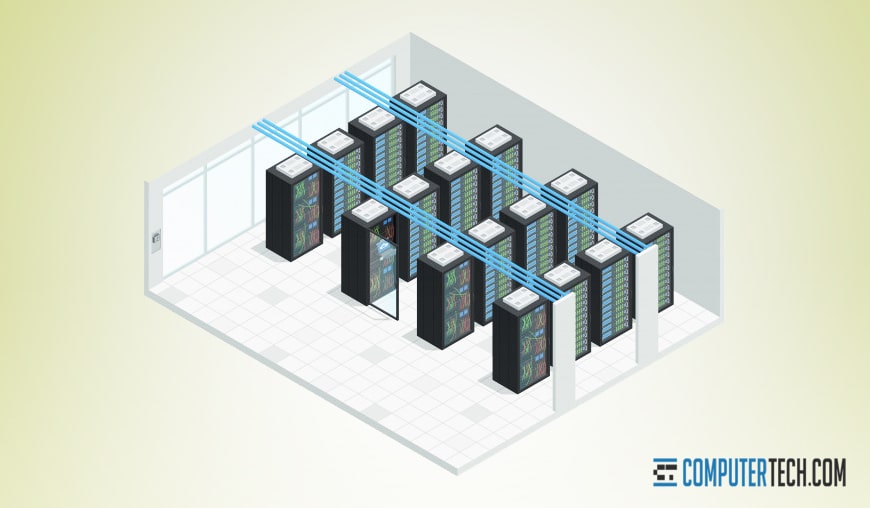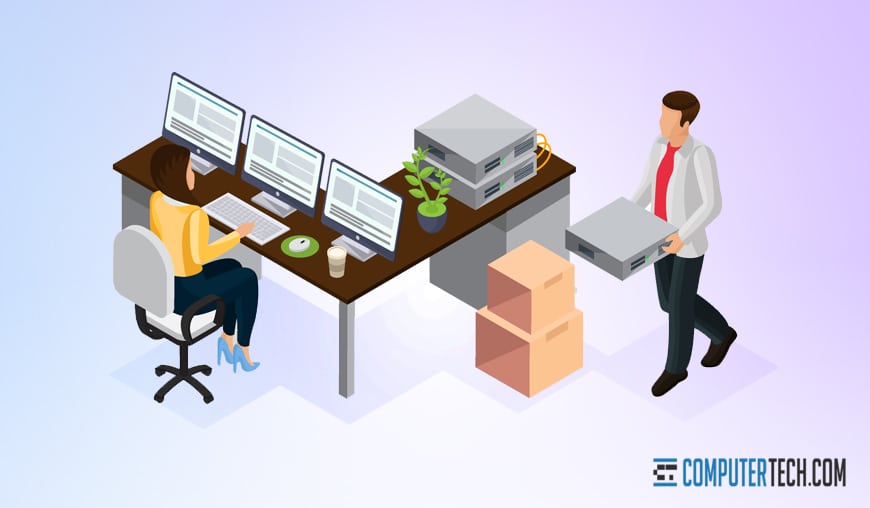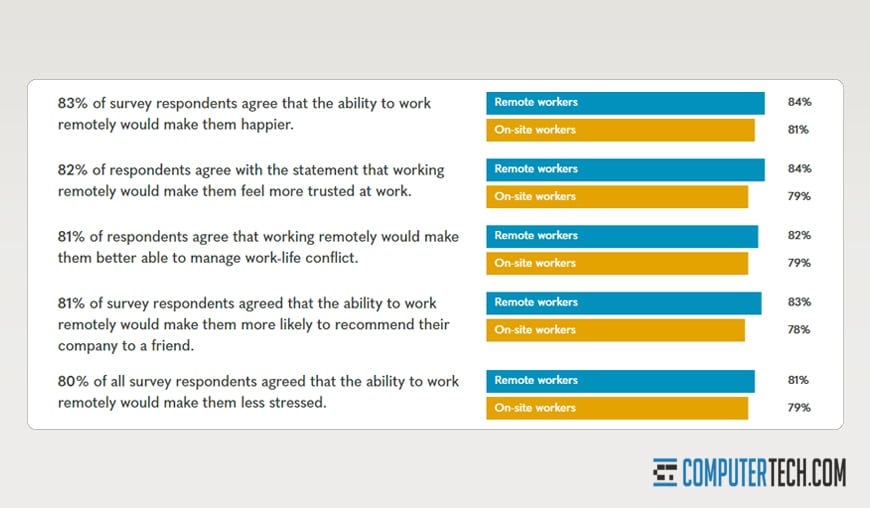-

When you’re looking to put together an information technology department for your business – whether it’s a single does-it-all guru or a larger department of developers, administrators, and tech – you have a major choice to make. Does your business need an onsite IT team, or can you get away with remote staff?
The answer depends on a few different factors, so let’s discuss those factors.
Where Is Your Infrastructure?
The modern business has a choice in setting up their IT infrastructure locally or remotely, just as you have the choice in hiring your workforce. Many small and mid-sized businesses have as little IT infrastructure in their offices as possible. Each employee gets their computer, usually a laptop with a dock and some local hardware, a phone, and maybe a few accessories. All of the rest, though? The software, the servers, the business applications? Those are all on the cloud.
One of the primary benefits of the cloud is that you generally don’t need to worry about a lot of the maintenance and hardware-related tasks. What if a hard drive starts to fail? What if a server needs upgrading? The data center hosting your server handles it. They also provide better access to the internet, with guaranteed uptime, much more easily than you can in the office.
If you don’t have a server in the office, you don’t need to have a server administrator in the office either. Tasks your administrator needs to complete will either be software-related, in which case they can use remote access to perform their tasks, or they will be hardware-related. Hardware-related tasks in a remote environment usually just require a phone call to the onsite techs working for the data center.

There are benefits and drawbacks to outsourcing your infrastructure like this. You have less control over the hardware, but you have better uptime and connection guarantees, and when a crisis occurs, you’ll have outsourced staff on hand to deal with it.
Who Does Your Staff Serve?
When you consider what a typical IT employee does from day to day, you might recognize that a large part of it is simply helpdesk-level tasks. Password resets, simple account management, minor details; you generally won’t have the need for specialized IT workers. So, for IT support and helpdesk services, who does your staff typically serve?
There are two possibilities: internal and external. Internal helpdesk handles support tickets and issues with your employees. What if an employee gets locked out when trying to access their account? Your IT staff assists them. Everything from setting up and managing internal accounts, onboarding new users, managing small issues, and putting out minor fires, are all internal tasks.
External helpdesk does a similar thing, but for users rather than employees. What if your customers need support for accessing your SaaS offering? They’re trying to reset their passwords but aren’t receiving emails? They were hacked and need their accounts to be reset? Your IT staff handles that.
How does this affect the determination of whether you’re going to hire onsite or remote IT workers? There’s generally one factor in play: hardware.

If your IT staff is primarily working with your employees, they may need to “get their hands dirty” with the actual hardware your employees are using. After all, sometimes the issue that occurs with a user’s computer is physical. A battery might be dead, a USB port might break, a cord might get lost, a machine might not power on. These kinds of issues are all difficult to diagnose and solve remotely.
In fact, generally, no matter what kind of support you need for your users, you’ll want at least one person locally on staff – or able to drive into the office as necessary – to handle local issues.
On the other hand, if your IT support is primarily for end-users, well, those end-users aren’t coming into your office, are they? Every task that is necessary to support an end-user can be performed remotely, with the right tools and access. Even issues with user hardware aren’t a problem, either because the answer is “mail us the computer and we’ll fix it” or “it’s not our problem; talk to your ISP/MSP/hardware vendor.”
Of course, if your IT staff handles both internal and external issues, you need a workforce that can handle them appropriately. That generally means either a hybrid workforce or an onsite workforce.
Do You Need Custom Development?
IT as a field encompasses more than just managing hardware and accounts. Sometimes you need ongoing development. Sometimes you need a specialized IT security crew. Sometimes you need someone there specifically to overview and audit your processes and apps for compliance with regulations.
A staff of developers can function entirely remotely. Many high-quality companies such as Buffer are entirely remote teams.

There are some unique challenges with running a remote workforce. Building a sense of camaraderie can be a challenge. A distributed workforce has to deal with all of the vagaries of working from home through different levels of technology, quality of ISP support, and other issues. Sometimes, the hassle isn’t worth the benefit of not having an office.
If your environment requires custom development, it may be better to have an onsite team that can work together in close quarters. Even in the best remote environment, response times can be slower than if your employees can just talk to one another. Waiting for an email response is always slower than just getting up and talking to whoever has the information your team member needs.
The Pros and Cons of Onsite IT
Looking into onsite IT services specifically, you can analyze a lot of pros and cons.
Pro: Your employees are less likely to have an adversarial relationship with the support team. A common problem with a remote IT team is that the rest of your employees view them with suspicion or outright distrust. Since they’re remote, the impression of a foreign call center or otherwise lower quality accessory team can grow and fester. Every small mistake and every delay is perceived as incompetence, and it means employees can often waste time and productivity suffering from bugs that could be solved if only they would bring them up.
Pro: Onsite IT can handle local hardware-specific issues faster and more easily than a remote team. If an uncommon or unexplained issue comes up, a remote employee needs to navigate the complex flowchart of diagnoses without laying eyes on the situation. An onsite employee can simply walk to the desk of the affected user and help. This makes it easier to diagnose simple but otherwise tricky issues to solve, like cords plugged into the wrong outlets, accidental caps lock, and other minor problems.
Pro: Your onsite IT staff can have a more strategic view. This is of particular concern if you have a staff who oversees things like what hardware is in use by your staff. An onsite IT staff can have a better view and awareness of the selection of hardware and software in play, and can better offer advice as to when elements need replacing or updating. They also tend to be more in tune with the needs of your users when they can be present in person.
Pro: Some problems can be resolved faster than if your staff is remote. This has already come up in a few different ways, but it’s worth noting directly. Onsite IT staff may be able to handle local issues faster than remote IT staff can. For customer issues, the response time is likely about the same, however.

Con: Paying for onsite IT limits your hiring pool and, often, the number of staff you can have on payroll. When you can only hire local people and you need to bring them into the office, costs are often higher. They’re more stable – you don’t usually need to pay crisis rates when something breaks in the middle of the night – but they’re higher as a baseline than hiring a freelancer or MSP to handle your services.
Con: Your onsite staff needs their full workshop environment for the greatest success. If your IT staff is handling more than just the basic level of support, they may need a full environment to work. That means servers and infrastructure used for testing and development, backup hardware, tools, and an office to hold it all. This is generally more expensive to set up than just hiring remote staff.
The Pros and Cons of Remote IT
Now let’s flip it all on its head and look at the pros and cons, inverted. What are the pros and cons of working with a remote IT staff instead of an onsite staff?
Pro: A distributed workforce doesn’t require office space. Remote IT workers either have their own offices (in the case of an MSP) or work from home. Your local office space can be smaller or, in the case of a 100% remote workforce, nonexistent. This can save a lot of money you would otherwise need to spend on things like rent and utilities.
Pro: You can get a better distribution of skills for a lower overall cost. This is especially true when you’re hiring freelancers or a company rather than remote employees. You may be able to hire someone for an overall lower cost due to where they live, what benefits you need to offer, what salary they can accept, and other factors.
Pro: Remote workers can more easily be on call around the clock. This is doubly true of hiring an MSP; an SLA or contract that specifies around-the-clock availability is a lot cheaper than paying a second/third shift of IT employees, or keeping some available with the offer of overtime pay when they need to be called in. Of course, off-hours support might only be necessary for the event of a crisis, and it’s hard to say how much a crisis response team should cost.
Pro: Remote workers often have higher morale. Studies have shown that being able to work remotely is often a huge selling point for self-motivated employees. Remote workers have higher morale, lower stress, and lower absenteeism. A survey performed by OWLLabs titled, “State of Remote Work“, tells us that a vast majority of workers would overall be happier by working remotely. The pandemic has shown that the need for managers looking over shoulders is largely overblown; most people want to work and work in their own way. As long as you can trust your employees to actually get their work done, there’s not necessarily a reason to require they do it in your office.

Con: Remote staff can often be viewed as roadblocks or adversaries rather than team members. How often have you heard a complaint about call centers being worthless? Trying to call a big business like a telecom company or ISP with an issue is like pulling teeth. That same kind of impression can trickle into the relationship between your staff and your remote IT department, even if your remote IT is entirely made up of employees rather than outsourced techs. It’s a difficult impression to bypass, as well.
Con: Depending on who you hire, there may be cultural or language barriers in place. The advantage of being able to hire people from anywhere to do your work can be balanced out by the barriers in place. Language, culture, time zones; a number of different issues can crop up depending on who you hire.
An Overall Solution
Largely, a remote IT workforce is fine for many businesses. Whether you’re hiring an MSP, a few freelancers, or actual employees to work remotely, you have a lot of flexibility in what you want to do. You may need a few onsite IT staff to handle things your remote workforce can’t, and a hybrid solution is often the best solution, but it can work either way.
The truth is, there’s no one solution that fits every business. For the best answer to what you should use, someone needs to analyze your specific circumstances. To that end, why not give us a call? We can help you determine what kind of service works best with your organization, and what sort of specific concerns you should keep in mind.
About The Author
Herman
Herman is the lead team member here at Computertech.com. He’s been in IT for over 20 years and has expertise in our various IT Services including Microsoft Azure, Microsoft 365, Microsoft Teams and even Computer Security.
No related posts.
IT Support | IT Services | IT Consultant | Computer Support
Speak to a Human (856) 347-2282
- Home
- About Us
- Services
- IT Support
- Managed IT Services
- IT Consulting and Strategy
- IT Security Services
- IT Infrastructure Services and Networking
- Help Desk and Onsite Support
- Communication and Collaboration
- Specialist IT Services
- Data Backup and Disaster Recovery
- Cloud Computing
- Optimizing Network Consulting Services
- Remote Monitoring and IT Management
- Business Computer Services and Consulting
- Blog
- Contact Us
Navigation- Home
- About Us
- » About Computer Tech
- » What To Expect
- Services
- » IT Support
- » Managed IT Services
- » IT Consulting and Strategy
- » IT Security Services
- » IT Infrastructure Services and Networking
- » Help Desk and Onsite Support
- » Communication and Collaboration
- » Specialist IT Services
- » Data Backup and Disaster Recovery
- » Cloud Computing
- » Optimizing Network Consulting Services
- » Remote Monitoring and IT Management
- » Business Computer Services and Consulting
- Blog
- Contact Us
Onsite IT vs Remote: How to Choose the Best for Your Business
In need of IT Services or IT Support? Call us today at (856) 347-2282
About Us
Computer Tech is an IT Consultant \ Computer Consultant firm providing Computer Support, IT Support and IT Services in South Jersey, IT Services Delaware, IT Services New Jersey, Philadelphia Pennsylvania.
(856) 347-2282Get started:
- 6 Things to Try if Your Work Laptop Won’t Boot Up
- The Ultimate Guide to IT Companies in New Jersey
- What is a Proactive IT Strategy and Why Do You Need One?
- How to Recover Data From a Broken Company Computer
- How NJ Businesses Are Outsourcing Their CIO and CTO Roles
- 8 Benefits of Using a Local New Jersey IT Company
- The Benefits of Managed IT Support Services for Businesses
- How Outsourced IT Support Can Help Employees Working Remotely
- [Guide] What Exactly Does an IT Support Company Do?
- Onsite IT vs Remote: How to Choose the Best for Your Business
Newsletter
Computer Tech, LLC.
105 Market Pl Suite 1, Glassboro, NJ 08028
(856) 347-2282
© Copyright 2025 HighTech Business Solutions. All Rights Reserved.



